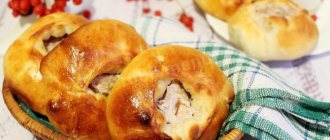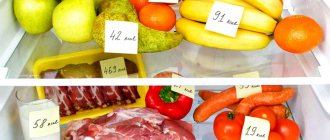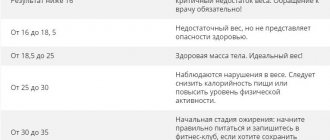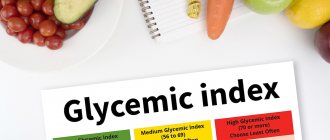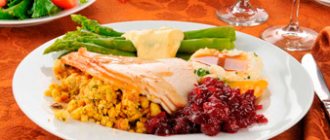About grain units
The name “bread unit” comes from the weight of a 25 gram slice of bread, which contains 12 grams of carbohydrates. Otherwise, 1XE = 12g. carbohydrates = 25g bread or ½ standard slice of regular loaf. This value was developed at the beginning of the 20th century in Germany. Today, there are some discrepancies in the quantitative composition of carbohydrates per 1 XE.
In the United States, one unit is equal to 15 grams, in Switzerland – to 10. The all-Russian XE is 12 g. The main purpose of bread (carbohydrate) units is the correct calculation of insulin doses relative to the amount of carbohydrates received by the body.
To avoid additional injections, it is necessary to control the amount of carbohydrates eaten. It is much more convenient to calculate XE. Twelve grams of carbohydrates increase glycemic levels by 2.5 mmol/l. To process 1 XE, a diabetic needs up to 2 doses of insulin units (IU).
During the day, the amount of insulin required per unit of bread may vary, depending on the general psychosomatic state, physical activity, individual response to insulin therapy, and the age category of the patient. The reference value for patients with type 1 diabetes is 24 bread units daily.
This value includes the sum of all carbohydrates consumed per day. Thus, the daily carbohydrate intake for diabetics should be within the range of 290–300 grams. Children's standards are slightly different:
| Age | from 4 to 6 years | from 7 to 10 years | from 11 to 14 years |
| Recommended amount of XE | 12–14 | 14–16 | 17–20 |
In case of non-insulin-dependent (insulin-resistant) type of disease, daily calculation of the qualitative and quantitative composition of carbohydrates can be used for weight loss. You just need to reduce the number of bread units, replacing some products with others.
According to the rules of the ninth diet, the diet includes six meals: three main, two additional and a light fermented milk drink an hour before going to bed. The distribution of XE norms for each meal should not be chaotic, but dividing them equally (4 units each) would be incorrect. According to the recommendations of nutritionists, in the first half of the day the carbohydrate load should be greater.
In the evening, as a rule, physical activity decreases, and the body requires less glucose, therefore, fewer carbohydrate units. Otherwise, unspent glucose is transformed into fats, which leads to a set of extra pounds. When planning the daily norm of XE, you need to focus on the following figures:
- morning meal - 5;
- lunch - 3;
- lunch - 6;
- afternoon snack - 3;
- evening meal - 5;
- at night - 2.
Diet at the first stage
The bread diet for weight loss begins from the first stage. During this period, up to 2.5 kg per week is lost. The duration of the first stage of weight loss is from 7 to 14 days. Women are supposed to include 8-12 slices of bread in their menu, men - 1.5 times more. It is best to buy a dietary product made from wholemeal flour, but you can replace it with regular rye flour, just halve the amount.
Important!
The bread diet categorically excludes baked goods. Eating buns, buns and cheesecakes increases blood sugar levels and increases stomach acidity.
The prescribed bread ration should be divided into equal portions and eaten every 3-4 hours, even if you are not hungry by this time.
Additions to the main product are:
- Vegetables (except starchy ones) in any quantity. They can be stewed, boiled, baked, or eaten raw. To prepare salads, you are allowed to use 1 tablespoon of vegetable oil per day.
- Low-fat cottage cheese, boiled fish, chicken, veal, cheese. Can be used in a very thin layer or slice for making sandwiches.
- A portion of stewed fish, meat, egg in any form. You can eat 3 times a week. These days, the amount of bread consumed is reduced by 2-4 slices. You should not include these products on the menu for several days in a row.
- 1 fruit (apple, pear, kiwi, orange, grapefruit) or 3 plums (a small handful of berries) daily.
- You can drink tea and coffee without sugar during each meal and in between.
- A glass of natural yogurt or kefir is a mandatory dish on the daily menu.
During this time, any sweets, mayonnaise, fatty sauces, butter, and alcohol are excluded.
Important!
You need to drink 8-10 glasses of pure water or mineral water without gases, herbal infusions, and green tea daily.
Menu creation
Counting bread units greatly simplifies the formation of a daily diet. Nutritionists recommend developing a menu for the week so that the food is not only correct in terms of the amount of food, but also varied in terms of tasty and healthy dishes. Using a scale and a calculator, a diabetic needs to evaluate all foods planned for consumption in the next seven days.
The more carefully each ingredient is calculated individually and their combination in a dish, the stricter the control over glycemic levels will be. With an occasional snack outside the home, a diabetic patient will be able to accurately calculate how many bread units he should aim for, and what dish on the menu he can replace with this snack. With the help of simple calculations, the patient will learn to manage diabetes.
Product selection
When choosing products based on the characteristics of bread units, one should not forget about other important parameters: GI and calorie content. You must immediately exclude:
- sweet desserts, rich pastries, confectionery;
- candies, waffles and other sweets not made specifically for diabetics;
- fast food dishes;
- smoked lard, meat and fish;
- chips, popcorn, flavored crackers and snacks;
- mayonnaise-based fatty sauces;
- sweet soda, ready-made packaged juices and bottled tea from the store;
- fatty meats (duck, pork, goose);
- canned food, including: stewed meat, meat and sprat pates, pickled vegetables and mushrooms, fruits in their own juice, canned fish;
- cereals with a high glycemic index (sago, white rice, semolina).
Products with an average glycemic index are allowed on the menu on a limited basis:
- semi-finished products with minced meat (dumplings, khinkali);
- beets and potatoes;
- flour products (pasta, noodles, pancakes, pancakes);
- fruits banana, persimmon, mango, kiwi;
- melons and fruits: pumpkin, watermelon, melon.
The correct food basket for a diabetic includes:
- all vegetables, berries and fruits with a GI from 0 to 30 units;
- legumes (beans, chickpeas, peas, lentils);
- cereals: egg, wheat, oats, buckwheat, pearl barley;
- bread: rye, whole grain;
- durum pasta;
- dietary meat (rabbit, chicken, turkey);
- seafood and fish;
- mushrooms, nuts, eggs;
- dairy and fermented milk products (low fat content).
Second stage menu composition
After the initial phase has been successfully completed, the diet can be varied by replacing every 2 slices of bread with another dish. For their preparation, durum wheat pasta, dark rice, buckwheat, legumes, oatmeal, chicken, fish, and veal are used. Daily fruit consumption increases 3 times. You can pamper yourself with boiled potatoes (1 medium size per day), an ear of corn, breakfast cereal (no more than 4 tablespoons per day).
Important details:
- The total serving size should not exceed 1 glass. In this case, the stomach will not stretch, constantly requiring more food to be full.
- The consumption of yogurt (kefir) and water remains mandatory.
- The frequency of meals does not change.
The duration of the second stage is not limited.
Results
Bread units for diabetes help to create a menu as accurately as possible. It is enough to know the formula for converting carbohydrates to protect yourself from eating food that can be harmful to your health.
Diet “by bread units” (XE) is a diet based on creating a menu according to the equivalence of certain dishes to bread units. One XE is equivalent to one 1.5 cm wide piece of loaf and 12 grams of carbohydrates.
The norm of bread units entering the body for a healthy person who does not follow any diets is 30 XE per day. For people who control their blood sugar levels and for those who want to lose excess weight, the value should be 10 XE.
According to this value, a special menu was compiled that excludes the following products from the diet:
- fast food and convenience foods;
- smoked meats;
- sugar, confectionery and baked goods;
- canned food;
- alcohol.
Prohibited foods
Foods that are not recommended for consumption on diet No. 9 include baked goods; sweet berries and fruits (especially dried), such as bananas, figs and grapes; fatty dairy products; beef and fatty meat, smoked meats; red and black caviar (due to the increased amount of salt); seeds and nuts; mayonnaise, cooking oil; drinks containing sugar; alcohol; sweets.
Important! A diet for diabetes should include 5-6 meals a day. In cooking, preference should be given to boiling, stewing and baking. Diet for type 1 diabetes Patients with type 1 diabetes are insulin dependent. They are prescribed a low-carbohydrate diet No. 9 B, which is specially adapted for the patient to receive short- and medium-acting insulin. It involves a clear calculation of consumed digestible carbohydrates using a system of bread units (according to international standards, 1 XE contains from 10 to 12 g).
Diet menu table by bread units
| Breakfast | Dinner | Dinner | |
| First day | Apple and carrot salad with lemon juice, coffee without sugar | Vegetarian borscht, dried fruit compote | Boiled chicken breast, natural unsweetened yogurt |
| Second day | White cabbage salad with olive oil, coffee with milk | Broccoli soup, apple compote | Grilled fish, 200 ml low-fat kefir |
| The third day | 2 apples, dried apricots, green tea | Vegetable soup, dried fruit compote | Boiled beef (150 gr.), a glass of curdled milk |
| Fourth day | 2 apples, raisins, coffee without sugar | Vegetarian borscht, dried fruit compote | Boiled brown rice with soy sauce, a glass of kefir (low-fat) |
| Fifth day | Apple, orange, green tea | Sauerkraut cabbage soup, plum compote | Boiled buckwheat with soy sauce, a glass of fermented baked milk |
| Sixth day | Carrot and apple salad with lemon juice, coffee | Sauerkraut cabbage soup, sauerkraut compote | Pasta with tomato sauce (200 gr.), a glass of curdled milk |
| Seventh day | Apple, banana, green tea | Borscht without meat, dried fruit compote | Grilled chicken fillet (200 gr.) glass of kefir |
After seven days, this menu is repeated. The duration of the bread unit diet to achieve a good result is at least two weeks. The first week is accompanied by fluid loss, and during the second, the body gets used to the new diet and just begins to break down its own fat.
When following this diet, you should take into account the lack of raw vegetables in the diet, which are a source of fiber. Contraindications for the diet are gastrointestinal and kidney diseases. Pregnant women, children and teenagers should not use this diet either.
If you find an error, please select a piece of text and press Ctrl+Enter.
Sample menu for the week
You can independently develop your own diet and nutrition regimen, taking into account your personal characteristics and health status, but this should be done in advance. Diabetes diet (treatment table) No. 9, which is described above, is ideal as a permanent diet for patients suffering from the second type of disease. Below is a kind of sample weekly menu, which is adjusted in accordance with the wishes of the patient.
Day 1
Breakfast first: low-fat cottage cheese, fresh vegetable salad, tea. Second breakfast: apple. Lunch: pickle soup (in vegetable or weak meat broth), seasoned with 15% fat sour cream, boiled chicken fillet with stewed cabbage. Afternoon snack: cottage cheese casserole with carrots, tea. Dinner: baked salmon with stewed vegetables, compote. Evening snack: a glass of low-fat kefir or yogurt.
Day 2
Breakfast one: buckwheat porridge, “Doctor’s” sausage, tea without sugar or with a synthetic sweetener. Breakfast two: carrot and apple salad. Lunch: fish soup, mashed potatoes, seasoned with low-fat cream or sour cream. Afternoon snack: cottage cheese soufflé, tea. Dinner: boiled rabbit, salad of radishes, cucumbers and herbs, dressed with olive oil, compote. Evening snack: apple.
Day 3
Breakfast first: cheesecakes, grated carrots, coffee. Second breakfast: 150 g of sprouted wheat. Lunch: pea soup, a slice of boiled turkey, tomato juice. Afternoon snack: a piece of Adyghe cheese, tea. Dinner: squash caviar, “Doctor’s” sausage, compote. Evening snack: a glass of low-fat kefir or yogurt.
Day 4
Breakfast first: millet porridge, soft-boiled chicken egg, coffee. Breakfast two: grated carrots seasoned with olive oil. Lunch: vegetable soup, steamed veal cutlet, boiled potatoes, compote. Afternoon snack: milk. Dinner: stewed mackerel with zucchini and carrots, tea. Evening snack: a slice of bread with yogurt.
Day 5
Breakfast first: protein omelet, fresh tomato salad with herbs, tea. Second breakfast: apple. Lunch: potato casserole with chicken, vegetarian borscht, cranberry juice. Afternoon snack: berry jelly with sweetener. Dinner: fish cutlets with steamed cauliflower, tea. Evening snack: carrot salad dressed with yogurt.
Day 6
Breakfast first: pearl barley porridge, boiled egg, coffee. Second breakfast: milk. Lunch: fresh cabbage soup, turkey meatballs, pea puree, tea. Afternoon snack: unsweetened pear. Dinner: baked mackerel with lemon, cabbage cutlets, compote. Evening snack: yogurt.
Day 7
Breakfast first: millet porridge with milk and pumpkin, tea with lemon. Second breakfast: curd pudding, coffee. Lunch: potato soup with boiled rabbit, fresh cabbage salad with cucumbers, cranberry juice. Afternoon snack: baked apple with nuts. Dinner: vinaigrette, diet sausages, fresh tomatoes, tea. Evening snack: a glass of low-fat kefir or yogurt.
You should know! Sprouted wheat is a real storehouse of nutrients. It will replenish the patient’s limited diet with vitamins, microelements and polyunsaturated fatty acids, so necessary for the body.
The nutrition plan described above is also suitable as a diet for gestational diabetes, which allows pregnant women to avoid excessive weight gain and limit their consumption of digestible carbohydrates, thereby preventing the disease from progressing to type 2 diabetes.
Prepared food for diabetics
Eating properly if you have diabetes requires a lot of effort and time. Most diabetics simply do not have enough time to properly plan menus and prepare food, so now I would like to tell you about one that helps make life easier for people with diabetes.
“Cryodiet” is a delivery service for ready-made and delicious food not only for diabetics, but also for people who want to lose weight. The menu was compiled by competent specialists - nutritionists and doctors.
Thanks to the use of special “shock freezing” technology, all you have to do is heat up your food in the microwave or slow cooker and have a delicious meal. Freezing preserves all nutrients.
The main advantages of "Cryodiet":
- production of products in an ecologically clean area of the Novgorod region;
- delivery without delay in person;
- variety of food;
- blast freezing (preserves food without preservatives);
- more affordable prices compared to competitors.
Examples of dishes:
The delivery service for ready-made food for diabetics operates in Moscow and St. Petersburg, so if you want to eat healthy dietary food and not spend a lot of time on it, order a weekly menu on the official website https://cryodiet.ru.
Israeli bread diet
After the unique discovery of Olga Raz, other nutritional systems based on losing weight with bread were created. Therefore, you have a choice which of the modern methods suits you best than others. But the most popular is still the Israeli bread diet from a professional in his field. It involves 2 stages.
Stage I
At this stage, active weight loss occurs. It is allowed to eat low-calorie bread with a thin layer of “spread” with a minimum amount of fat. On the day it is recommended to eat:
- women - up to 12 pieces;
- for men - up to 16.
The diet is supplemented with protein foods and vegetables. The duration of the stage is 2 weeks.
Authorized products:
- sandwiches with cottage cheese (up to 5% fat), fish (even salted), lean meat (chicken, turkey, quail, beef, veal);
- ham;
- vegetables without starch: cabbage, zucchini, bell peppers, tomatoes, broccoli, asparagus, green peas, lettuce;
- eggs (three times a week);
- fermented milk drinks (yogurt, fermented baked milk and kefir) - a glass a day;
- three times a week you need to eat meat or fish with vegetables, but on such days the serving size of bread is reduced by a third;
- fruits: plums, avocados, apples, pears (1 piece per day);
- vegetable oil in small quantities for salad dressing;
- coffee (occasionally), green tea, vegetable juices (celery, tomato, carrot).
Stage II
This stage represents consolidation of the achieved results. The goal is not to regain lost weight. The diet is gradually expanded with other products. The duration of the stage depends on individual indicators. On average - 2-3 weeks.
Authorized products:
- porridge;
- pasta;
- potatoes (1 piece per day);
- legumes: beans, lentils;
- the portion of fruit increases (3 pieces per day).
For both stages there is a list of prohibited products:
- sweets: honey, sugar, sweets, confectionery, chocolate, marmalade;
- smoked foods, pickles, sauces, marinades;
- alcohol;
- ketchup, mayonnaise;
- carbonated drinks;
- bakery;
- preserves and jams;
- food with animal fats;
- fat meat;
- some dairy products: milk, homemade cottage cheese, sour cream.
With such a diet, fats practically do not enter the body, which means that it will not have the opportunity to store them in reserve.
DAILY REQUIREMENT
- Proteins - 80-120 grams or approximately 1-1.5 grams per 1 kilogram of body weight (but not lower than 0.75 grams per 1 kilogram of body weight).
- Fats - from 30 to 80-100 grams.
- Carbohydrates - on average 300-400 grams.
Naturally, the weight of products containing these components is much higher; so that 100 g of protein gets into the body, you need to eat 0.5 kg of beef or 0.55 kg of low-fat cottage cheese.
These diets are useful for diabetes mellitus with obesity and for the prevention of complications.
CUCUMBER diet for obesity, hypertension and diabetes mellitus with obesity - 300 g of fresh cucumbers without salt 5 times a day, only 1.5 kg.
SALAD diet for obesity, atherosclerosis, hypertension, diabetes with obesity, nephritis - fresh raw vegetables and fruits, their combinations 5 times a day, 250-300 g without salt with the addition of vegetable oil or sour cream.
MILK (kefir) diet for obesity, atherosclerosis, hypertension and diabetes mellitus with obesity - 200-250 g of milk, kefir 6 times a day, only 1.2-1.5 liters.
COOK diet for obesity, diabetes mellitus, atherosclerosis and hypertension with obesity, circulatory failure, liver and biliary tract diseases - 100 g of cottage cheese with 9% fat content 5 times a day. In addition, 2 glasses of tea, 1 glass of rosehip decoction, 2 glasses of low-fat kefir, 1 liter of liquid in total. An option is the cottage cheese-kefir diet ; 60 g of cottage cheese 9% fat and 1 glass of kefir (milk) 5 times a day: and 1 liter of kefir (milk).
Sour cream (fat) diet for obesity, less often for diabetes mellitus with obesity - 80 g of sour cream with 20-30% fat content 5 times a day, 400 g in total, 1-2 glasses of rosehip decoction.
MEAT (fish) diet for obesity, atherosclerosis and diabetes mellitus with obesity - 80 g of lean boiled meat or boiled fish 5 times a day, 400 g in total. 100-150 g of vegetables (cabbage, carrots, cucumbers, tomatoes) 5 times a day, total 0.6-0.9 kg. 1-2 glasses of tea without sugar.
OATH diet for obesity, diabetes mellitus with symptoms of metabolic acidosis, atherosclerosis with obesity - 140 g of oatmeal with water 5 times a day.
JUICE diet for obesity, atherosclerosis, hypertension and diabetes mellitus with obesity, kidney, liver and biliary tract diseases, gout, urolithiasis without phosphaturia - 600 ml of vegetable or fruit juice, diluted with 200 ml of water or 0.8 liters of rosehip decoction. For 4 doses.
RICE-COMPOTE - 6 times a day, a glass of sweet compote, 2 times along with sweet rice porridge, cooked in water without salt. Per day 1.5 kg of fresh or 240 g of dry fruits, 50 g of rice, 120 g of sugar.
LiveInternetLiveInternet
I hope this article helps someone!
What are Bread Units and what are they “eaten with”?
When compiling a daily menu, you should consider only those foods that increase blood sugar levels. In a healthy person, the pancreas produces the required amount of insulin in response to food intake. As a result, blood sugar levels do not rise. With diabetes, in order to maintain optimal blood sugar levels, we are forced to administer insulin (or glucose-lowering drugs) from the outside, independently changing the dose depending on what and how much the person has eaten. That’s why it’s important to learn how to correctly count those foods that increase blood sugar.
How to do it?
You don't have to weigh your food every time! Scientists studied the products and compiled a table of their carbohydrate content or Bread Units - XE for people with diabetes.
1 XE is the amount of product that contains 10 g of carbohydrates. In other words, according to the XE system, those foods that belong to the group that increase blood sugar levels are calculated - these are grains (bread, buckwheat, oats, millet, pearl barley, rice, pasta, noodles), fruits and fruit juices, milk, kefir and other liquids. dairy products (except low-fat cottage cheese), as well as some varieties of vegetables - potatoes, corn (beans and peas - in large quantities). but of course, chocolate, cookies, candies are certainly limited in the daily diet, lemonade and sugar in their pure form should be strictly limited in the diet and used only in case of hypoglycemia (low blood sugar).
The degree of cooking will also affect your blood sugar level. For example, mashed potatoes will raise your blood sugar levels faster than boiled or fried potatoes. Apple juice gives a faster rise in blood sugar compared to eating an apple, just like polished rice than unpolished rice. Fats and cold foods slow down the absorption of glucose, and salt speeds it up.
For the convenience of preparing a diet, there are special tables of Bread Units, which provide data on the amount of various carbohydrate-containing products containing 1 XE (I will give it below).
It is very important to learn how to determine the amount of XE in the foods you eat!
There are a number of foods that do not affect blood sugar levels:
these are vegetables - any type of cabbage, radishes, carrots, tomatoes, cucumbers, red and green peppers (with the exception of potatoes and corn),
greens (sorrel, dill, parsley, lettuce, etc.), mushrooms,
butter and vegetable oil, mayonnaise and lard,
as well as fish, meat, poultry, eggs and products made from them, cheese and cottage cheese,
nuts in small quantities (up to 50 g).
A slight rise in sugar is given by beans, peas and beans in small quantities as a side dish (up to 7 tbsp. l)
How many meals should you have during the day?
There must be 3 main meals, and intermediate meals, so-called snacks from 1 to 3, are also possible, i.e. There can be a total of 6 meals. When using ultra-short insulins (Novorapid, Humalog), it is possible to avoid snacking. This is acceptable if there is no hypoglycemia (low blood sugar) when skipping a snack.
In order to correlate the amount of digestible carbohydrates consumed with the dose of short-acting insulin administered,
a system of grain units was developed.
- 1XE = 10-12 g of digestible carbohydrates
- For 1 XE, 1 to 4 units of short (food) insulin are required
- On average, 1 XE requires 2 units of short-acting insulin
- Everyone has their own need for insulin per 1 XE. Determine it using a self-monitoring diary
- Bread units should be counted by eye, without weighing the products
How to calculate how much XE you need to eat during the day?
To do this, you need to return to the topic “Rational Nutrition”, calculate the daily calorie content of your diet, taking 55 or 60% of it, determine the number of kilocalories that should come from carbohydrates. Then, dividing this value by 4 (since 1g of carbohydrates gives 4 kcal), we get the daily amount of carbohydrates in grams. Knowing that 1 XE is equal to 10 grams of carbohydrates, we divide the resulting daily amount of carbohydrates by 10 and get the daily amount of XE.
For example, if you are a man and work physically at a construction site, then your daily caloric intake is 1800 kcal,
60% of it is 1080 kcal. Dividing 1080 kcal by 4 kcal gives you 270 grams of carbohydrates.
Dividing 270 grams by 12 grams, we get 22.5 XE.
For a woman working physically - 1200 - 60% = 720: 4 = 180: 12 = 15 XE
The standard for an adult woman and not to gain weight is 12 HE. Breakfast - 3XE, lunch - 3XE, dinner - 3XE and snacks 1 XE
How to distribute these units throughout the day?
Considering the presence of 3 main meals (breakfast, lunch and dinner), the bulk of carbohydrates should be distributed between them,
taking into account the principles of rational nutrition (more in the first half of the day, less in the evening)
and, of course, taking into account your appetite.
It should be borne in mind that it is not recommended to eat more than 7 XE at one meal, since the more carbohydrates you eat at one meal, the higher the rise in glycemia will be and the dose of short-term insulin will increase.
And the dose of short-term, “food” insulin, administered once, should not be more than 14 units.
Thus, the approximate distribution of carbohydrates between main meals could be as follows:
- 3 XE for breakfast (for example, oatmeal - 4 tablespoons (2 XE); sandwich with cheese or meat (1 XE); unsweetened cottage cheese with green tea or coffee with sweeteners).
- Lunch - 3 XE: fresh cabbage soup with sour cream (not counted according to XE) with 1 slice of bread (1 XE), pork chop or fish with vegetable salad in vegetable oil, without potatoes, corn and legumes (not counted according to XE), mashed potatoes - 4 tablespoons (2 XE), a glass of unsweetened compote
- Dinner - 3 XE: vegetable omelette of 3 eggs and 2 tomatoes (do not count according to XE) with 1 slice of bread (1 XE), 1 glass of sweet yoghurt (2 XE).
Thus, the total is 9 XE. “Where are the other 3 HE?” - you ask.
The remaining XE can be used for so-called snacks between main meals and at night. For example, 2 XE in the form of 1 banana can be eaten 2.5 hours after breakfast, 1 XE in the form of an apple - 2.5 hours after lunch and 1 XE at night, at 22.00, when you introduce your “night” extended-release insulin .
The break between breakfast and lunch should be 5 hours, and the same between lunch and dinner.
After the main meal, 2.5 hours later there should be a snack = 1 XE
Are intermediate meals and nighttime meals required for all people taking insulin?
Not required for everyone. Everything is individual and depends on your insulin therapy regimen. Very often we have to deal with a situation where people have had a heavy breakfast or lunch and don’t want to eat at all 3 hours after eating, but, remembering the recommendations to have a snack at 11.00 and 16.00, they forcefully “stuff” XE into themselves and increase their glucose levels.
Intermediate meals are required for those who are at increased risk of hypoglycemia 3 hours after eating. This usually happens when, in addition to short-acting insulin, long-acting insulin is administered in the morning, and the higher the dose, the more likely hypoglycemia is at this time (the time when the maximum effect of short-acting insulin accumulates and the onset of action of long-acting insulin).
After lunch, when long-acting insulin is at its peak of action and overlaps with the peak of action of short-acting insulin administered before lunch, the likelihood of hypoglycemia also increases and to prevent it, taking 1-2 XE is necessary. At night, at 22-23.00, when you administer long-acting insulin, a snack in the amount of 1-2 XE (slowly absorbed) to prevent hypoglycemia is needed if glycemia at this time is less than 6.3 mmol/l.
When glycemia is above 6.5-7.0 mmol/l, a snack at night can lead to morning hyperglycemia, since there is not enough “night” insulin. Intermediate meals intended to prevent hypoglycemia during the day and at night should be no more than 1-2 XE, otherwise instead of hypoglycemia you will get hyperglycemia. For intermediate meals taken for preventive purposes in an amount of no more than 1-2 XE, no additional insulin is administered.
Much is said about grain units in detail. But why do you need to be able to count them? Let's look at an example.
Let's say you have a glucometer and measure your blood glucose before meals. For example, you, as always, injected 12 units of insulin prescribed by your doctor, ate a bowl of porridge and drank a glass of milk. Yesterday you also administered the same dose and ate the same porridge and drank the same milk, and tomorrow you must do the same.
Why? Because as soon as you deviate from your usual diet, your glycemic indicators immediately change, and they are not ideal anyway. If you are a literate person and know how to count XE, then changes in your diet are not scary for you. Knowing that for 1 XE on average there are 2 units of short-acting insulin and knowing how to count XE, you can vary the composition of the diet, and therefore the dose of insulin at your discretion, without compromising diabetes compensation. This means that today you can eat porridge for breakfast for 4 XE (8 tbsp), 2 slices of bread (2 XE) with cheese or meat and inject 12 IU of short-term insulin into these 6 XE and get a good glycemic result.
Tomorrow morning, if you don’t have an appetite, you can limit yourself to a cup of tea with 2 sandwiches (2 XE) and inject only 4 units of short-acting insulin, and still get a good glycemic result. That is, the bread unit system helps to administer exactly as much short-term insulin as is necessary for the absorption of carbohydrates, no more (which is fraught with hypoglycemia) and no less (which is fraught with hyperglycemia), and maintain good compensation for diabetes.
Foods that can be consumed without restrictions
all vegetables except potatoes and corn
- cabbage (all types) - cucumbers - lettuce - greens - tomatoes - peppers - zucchini - eggplants - beets - carrots - green beans - radishes, turnips - green peas (young) - spinach, sorrel - mushrooms - tea, coffee without sugar and cream - mineral water - drinks with sweeteners
Vegetables can be consumed raw, boiled, baked, or pickled.
The use of fats (butter, mayonnaise, sour cream) in preparing vegetable dishes should be minimal.
Foods to eat in moderation
- lean meat - lean fish - milk and fermented milk products (low-fat) - cheeses less than 30% fat - cottage cheese less than 5% fat - potatoes - corn - mature legumes (peas, beans, lentils) - cereals - pasta - bread and bakery products products (non-buttery) - fruits - eggs
“Moderate amount” means half of your usual serving.
Products that need to be excluded or limited as much as possible
- butter - vegetable oil* - lard - sour cream, cream - cheeses more than 30% fat - cottage cheese more than 5% fat - mayonnaise - fatty meat, smoked meats - sausages - fatty fish - poultry skin - canned meat, fish and vegetable in oil - nuts, seeds - sugar, honey - preserves, jams - candies, chocolate - pastries, cakes and other confectionery products - cookies, pastry products - ice cream - sweet drinks (Coca-Cola, Fanta) - alcoholic beverages
If possible, avoid cooking food such as frying. Try to use cookware that allows you to cook food without adding fat.
* - vegetable oil is a necessary part of the daily diet, but it is enough to consume it in very small quantities.
Calculation of the amount of XE in the finished product:
Calculation of bread units of a product in factory packaging is very simple.
All factory products indicate the amount of carbohydrates in 100 g of products,
which must be divided by 12 and multiplied by the weight of the package.
Let's get the amount of XE in a given product package. Then simply divide by XE
To calculate bread units in a restaurant or in the home kitchen you need: a recipe for a prepared dish, a table of bread units, a calculator.
For example, we took 9 tablespoons of flour (1 tablespoon = 1 bread unit, 9 in total), 1 glass of milk (1 bread unit), 1 tablespoon of sunflower oil (no XE), 1 egg (no XE). We baked 10 pancakes. This means 1 pancake = 1 unit of bread.
Or, for example, one cutlet (70 g) consists of meat and bread, rolled in flour and sprinkled with breadcrumbs. It turns out that one cutlet = 1 bread unit.
Thus, to summarize, we can draw the following conclusion that nutrition for diabetes is not the maximum restriction of everything edible, as it seems at first glance.
Such food can be not only healthy and dietary, but also tasty and varied!
Table of bread units
Milk[/td]
| Dairy | ||
| The product's name | Quantity per 1 XE | Volume, weight per 1 XE |
| 1 glass | 200 ml | |
| Baked milk | 1 glass | 200 ml |
| Kefir | 1 glass | 250 ml |
| Kefir bifidok | 1 glass | 250 ml |
| Acidophilus sweet | 1/2 cup | 100 ml |
| Natural unsweetened yogurt (bio) | 1 glass | 250 ml |
| Fruit yoghurt | 75-100 g | |
| Cream | 1 glass | 200 ml |
| Buttermilk | 1 glass | 300 ml |
| Curdled milk | 1 glass | 200 ml |
| Ryazhenka | 1 glass | 200 ml |
| Milk ice cream (without glaze and waffles) | 65 g | |
| Creamy ice cream (in glaze and waffles) | 50 g | |
| Condensed milk without sugar (can volume 400g) | 1/3 can | 130 g |
| Powdered milk powder | 1 tbsp. spoon | 30 g |
| Cheesecake medium (with sugar) | 1 piece | 75 g |
| Sweet curd mass (without glaze and raisins) | 100 g | |
| Children's glazed cheese curds | 2/3 pieces | 35 g |
| Curd mass with raisins (sweet) | 35-40 g | |
| Cereals, cereals, flour products | ||
| The product's name | Quantity per 1 XE | Volume, weight per 1 XE |
| Wholemeal rye bread | 1 piece 1.5 cm thick | 35 g |
| White, gray bread (except butter bread) | 1 piece 1 cm thick | 20 g |
| Black bread | 1 piece 1 cm thick | 25 g |
| Bran bread | 1 piece 1.3 cm thick | 30 g |
| Borodinsky, Riga, aromatic bread | 1 piece 0.6 cm thick | 15 g |
| Rye bread | 1 piece 1 cm thick | 25 g |
| Crispbread | 2 pieces | 20 g |
| Breadsticks | quantity depends on size | 20 g |
| Unsweetened crackers | 2 pieces | 20 g |
| Unsweetened dryers | 1.5-2 pieces | 20 g |
| Crackers - large - medium - small | 2 pieces 5 pieces 15 pieces | 20 g 20 g 20 g |
| Pita | 20 g | |
| Butter bun | 20 g | |
| Frozen puff pastry | 35 g | |
| Frozen yeast dough | 25 g | |
| Damn thin | 1 large | 30 g |
| Frozen pancakes with cottage cheese | 1 piece | 50 g |
| Frozen empanadas | 1 piece | 50 g |
| Frozen dumplings with cottage cheese | 4 pieces | 50 g |
| Frozen dumplings with cottage cheese | 4 pieces | 50 g |
| Cheesecake | 0.5 pieces | 50 g |
| Wafers are small | 1.5 pieces | 17 g |
| Flour | 1 tbsp. heaped spoon | 15 g |
| Gingerbread | 1/2 pieces | 40 g |
| Pancakes | 30 g | |
| Breadcrumbs | 1 tbsp. heaped spoon | 15 g |
| Butter cookies | 1-2 pieces depending on size | 15 g |
| Any raw cereal | 1 tbsp. heaped spoon | 15 g |
| Any porridge | 2 tbsp. heaped spoon | 50 g |
| Cereals | 2 tbsp. heaped spoon | 15 g |
| Wheat bran | 12 tbsp. spoons | 15 g |
| Pasta | depending on the form from 1 to 4 tbsp. spoons | 50 g |
| Boiled pasta | depending on the shape from 2 to 4 tbsp. spoons | 15 g |
| Potatoes and mature legumes, some types of vegetables | ||
| The product's name | Quantity per 1 XE | Volume, weight per 1 XE |
| Dried beans | 1 tbsp. spoon | 20 g |
| Boiled beans | 3 tbsp. spoon | 50 g |
| Jacket potatoes | 1 piece | 75 g |
| Frozen potato pancakes | 60 g | |
| Potatoes, raw, boiled | 1 piece (the size of a large chicken egg) | 65 g |
| Mashed potatoes | 2 tbsp. spoons | 75 g |
| Fried potato | 1.5-2 tbsp. spoons depending on the cut | 35 g |
| Potato chips | 1 sachet small | 25 g |
| Corn(cob) | 0.5 pieces | 100 g |
| Canned corn | 3 tbsp. spoons | 70 g |
| Boiled corn | 3 tbsp. spoons | 50 g |
| Cornflakes | 4 tbsp. spoons | 15 g |
| Boiled beans | 3 tbsp. spoons | 50 g |
| Boiled lentils | 2 tbsp. heaped spoons | 50 g |
| Fruits and berries | ||
| The product's name | Quantity per 1 XE | Volume, weight per 1 XE |
| Apricot | 4 pieces | 120 g |
| Avocado | 1 piece | 200 g |
| Quince | 1 piece | 140 g |
| Cherry plum | 4 pieces | 140 g |
| A pineapple | 1 slice with peel | 140 g |
| Orange | 1 piece with peel | 130 g |
| Watermelon | 1 slice with peel | 270 g |
| Banana | 1/2 piece with peel | 70 g |
| Cowberry | 7 tbsp. spoon (1 glass) | 140 g |
| Grape | 10 pieces | 70 g |
| Cherry | 15 pieces(1 glass) | 90 g |
| Pomegranate | 1 piece | 170 g |
| Grapefruit | 1/2 piece with peel | 170 g |
| Pear | 1 piece | 100 g |
| Melon-“collective farmer” | 1 slice with peel | 100 g |
| Blackberry | 8 tbsp. spoon (1 glass) | 140 g |
| Strawberries | 8 tbsp. spoon (1 glass) | 150 g |
| Figs | 1 piece | 80 g |
| Kiwi | 1 piece | 110 g |
| Strawberry | 10 pieces(1 glass) | 160 g |
| Cranberry | 1 glass | 160 g |
| Gooseberry | 6 tbsp. spoon (1 glass) | 120 g |
| Raspberries | 8 tbsp. spoon (1 glass) | 150 g |
| Mango | 1 piece | 11 g |
| Tangerines | 3 pieces | 150 g |
| Nectarine | 1 piece | 120 g |
| Peach | 1 piece | 120 g |
| Papaya | 1/2 pieces | 140 g |
| Blue plums | 4 pieces | 90 g |
| Currant | 7 tbsp. spoon (1 glass) | 140 g |
| Feijoa | 10 pieces | 160 g |
| Persimmon | 1 piece | 70 g |
| Cherries | 10 pieces(1 glass) | 100 g |
| Blueberry | 7 tbsp. spoon (1 glass) | 140 g |
| Rose hip | 3 tbsp. heaped spoons | 60 g |
| Apple | 1 piece | 100 g |
| Juices | 1/2 cup | 100 ml |
| Sweets and other products | ||
| The product's name | Quantity per 1 XE | Volume, weight per 1 XE |
| Sugar jam | 1 tbsp. spoon | 120 g |
| Kvass | 1 glass | 120 g |
| Kissel | 1 glass | 120 g |
| Compote | 1 glass | 120 g |
| Chocolate candy. | 1 piece | 120 g |
| Dried fruits | 15 g | |
| Honey | 1 tbsp. spoon | 120 g |
| Pudding | 120 g | |
| Marmalade | 120 g | |
| Lump sugar | 2 pieces | 12 g |
| Granulated sugar | 1 tbsp. spoon | 12 g |
| Chocolate | 1/5 tile | 20 g |
| Pizza | 1/6 pieces | 50 g |
| Cake pie | 1 piece | 3-8 XE |
These are just the basics! Take care of yourself and your loved ones! Kapochka Kapa
Materials used from www.gorod21veka.ru
Sample menu
The bread diet is difficult, first of all, in creating a menu. To make this task easier, we offer you an approximate option for 7 days using the system from Olga Raz:
Menu for the week based on bread units
If you can’t go on a diet because you feel hungry, it makes sense to turn to this weight loss method. Bread, despite all its caloric content, will allow you to put your diet in order, improve your well-being, and most importantly, it will not allow you to suffer due to lack of energy. With this product, it is much easier to fight excess weight than with any other mono-diet - you can see this for yourself.
Vegetables, legumes, nuts
Vegetables, legumes and nuts must be present in the diet of people with diabetes. They help control blood glucose levels, reduce the risk of complications, in particular the development of cardiovascular diseases, and enrich the human body with microelements such as potassium, fiber, and protein. Get into the habit of using raw vegetables as a snack. Try to choose vegetables with a low glycemic index and significantly limit your intake of starchy vegetables, which are high in calories and carbohydrates.
| Product | Quantity of product per 1 XE | |
| raw and boiled potatoes (medium) | 1 PC. | 75 g |
| mashed potatoes | 2 tbsp. spoons | 90 g |
| fried potatoes | 2 tbsp. spoons | 35 g |
| chips | — | 25 g |
| carrots (medium) | 3 pcs. | 200 g |
| beets (medium) | 1 PC. | 150 g |
| beans (dried) | 1 tbsp. spoon | 20 g |
| beans (boiled) | 3 tbsp. spoons | 50 g |
| peas (fresh) | 7 tbsp. spoons | 100 g |
| beans (boiled) | 3 tbsp. spoons | 50 g |
| nuts | — | 60-90 g (depending on type) |
| pumpkin | — | 200 g |
| Jerusalem artichoke | — | 70 g |
Consumption rate
How many bread units should be consumed per meal and throughout the day depends on age, gender, weight and physical activity.
It is recommended to calculate your food intake so that it contains about 5 XE. Some norms of bread units per day for adults:
- People with a normal BMI (body mass index) with sedentary work and a sedentary lifestyle - up to 15-18 XE.
- People with a normal BMI in occupations requiring physical labor - up to 30 XE.
- Patients with overweight and obesity with low physical activity - up to 10-12 XE.
- People with excess body weight and high physical activity - up to 25 XE.
For children, depending on age, it is recommended to use:
- at 1-3 years – 10-11 XE per day;
- 4-6 years – 12-13 HE;
- 7-10 years – 15-16 HE;
- 11-14 years old – 16-20 HE;
- 15-18 years old – 18-21 HE.
At the same time, boys should receive more than girls. After 18 years of age, the calculation is made in accordance with adult values.
Features of the diet for diabetics
Previously, a system of dietary restrictions was the only method to curb hyperglycemia or elevated glucose levels. Now the patients' diet has expanded significantly. Diabetics are advised to follow several important rules for effective blood glucose control.
Patients should not go hungry or overeat. These conditions are dangerous to their health. It is necessary to eat so that the amount of carbohydrates consumed is evenly distributed throughout the day.
General dietary requirements:
- split meals (at least 6 times a day);
- calculation of consumed carbohydrates;
- limiting animal fats;
- introduction of plant foods into the diet;
- preference for food steamed, oven-baked, or boiled;
- avoiding or limiting foods that increase carbohydrate load;
- balanced diet;
- replacing sugar with substitutes;
- consumption of coarse fiber foods;
- compliance with the drinking regime;
- reducing salt intake;
- excluding alcohol.
You can diversify your diet by purchasing cookware that allows you to cook food without oil.
To ensure that carbohydrates are absorbed more slowly and do not provoke spikes in blood sugar, you should adhere to the following recommendations:
- Eat food with a rough or grainy consistency, such as crumbly porridge instead of pureed or boiled.
- Dishes should not be hot, as temperature affects the absorption of glucose.
- Fiber in foods inhibits the absorption of simple carbohydrates and helps remove cholesterol.
- Simple carbohydrates are best consumed after the main meal.
The menu can include foods that contain simple carbohydrates with fiber, such as fruits and berries. The absorption of glucose slows down if consumed with proteins (protein cream) or fats. However, do not forget that “slow” carbohydrates are also absorbed into the blood, increasing sugar.
